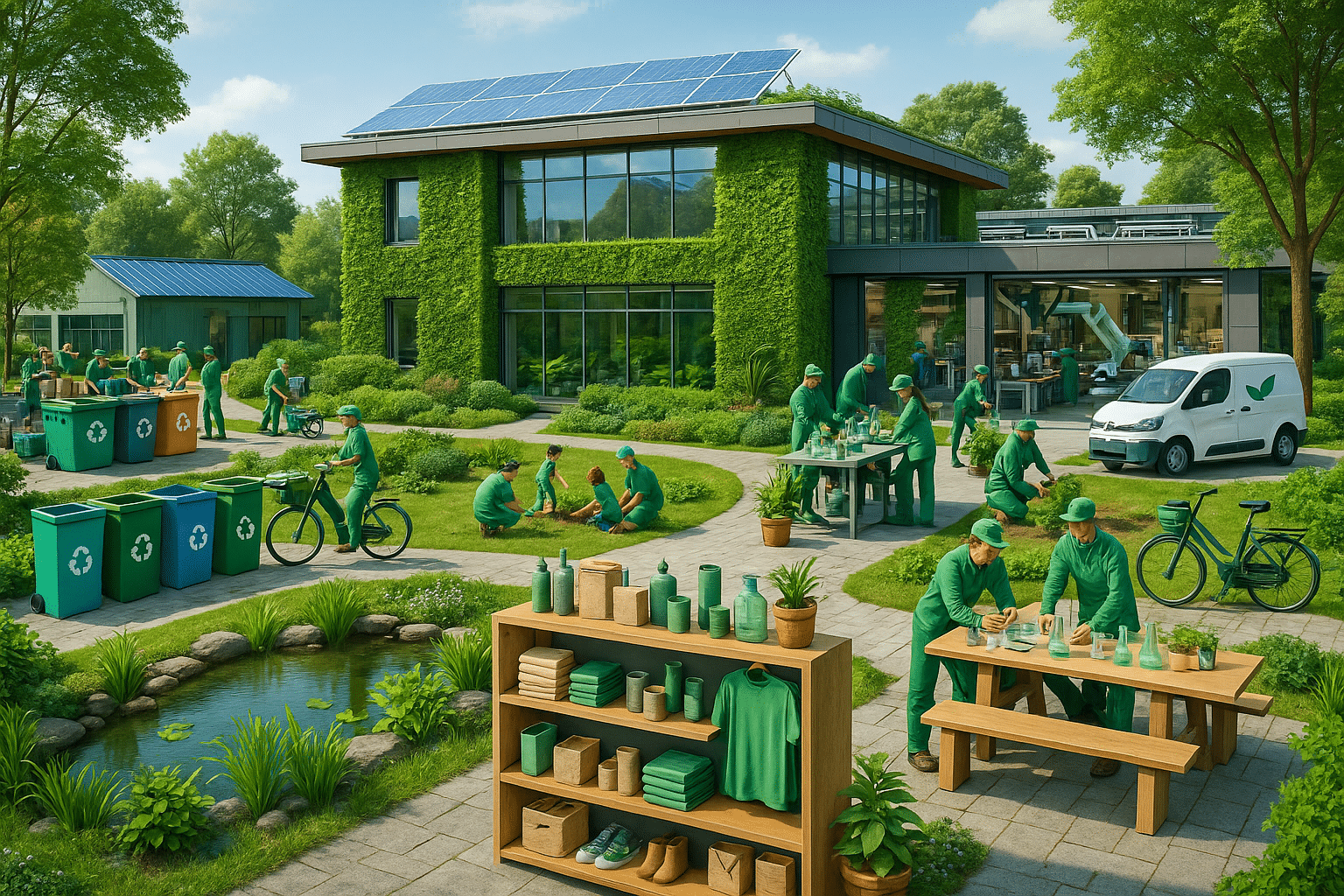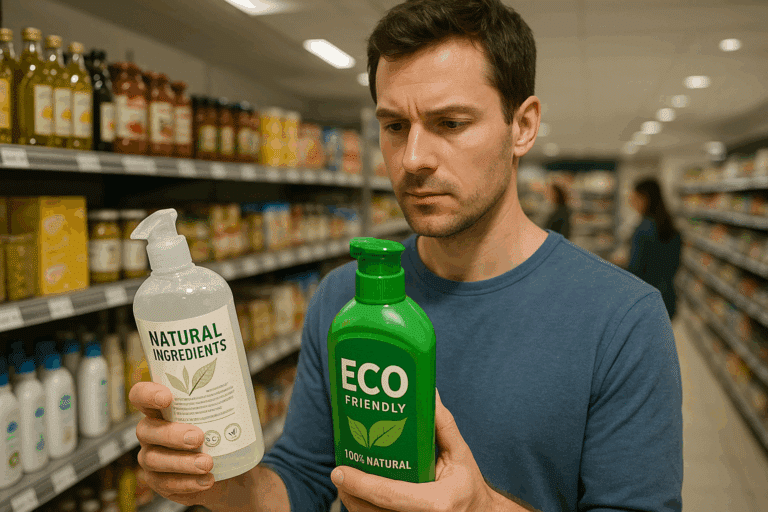🌱 A world where we continuously repurpose, refurbish, and recycle materials to fuel our economies, ensuring a greener, cleaner, and sustainable future. This is not the plot of a sci-fi novel but a representation of what the ‘Circular Product Economy’ envisions.
The Circular Product Economy (CPE) is a disruptive and innovative model that could transform the linear “take-make-waste” economic framework we’ve become all too familiar with, into a regenerative loop of “reduce-reuse-recycle”. 🔄 By embracing CPE, we can revolutionize sustainability and make strides towards combating climate change.
In this comprehensive exploration of the CPE, we will dive into the fundamental principles behind this revolutionary concept, its benefits, and how technology and innovative thinking are facilitating its implementation. Our journey will take us through various industries to showcase real-world applications and the transformative potential of a circular economy.
Right off the bat, it’s essential to understand that the Circular Product Economy is more than a simple recycling strategy; it represents a holistic shift in our perception and interaction with the material world. This article aims to make you conversant with the dynamics of CPE and equip you with knowledge to recognize and capitalize on opportunities it presents.
The Basics of Circular Product Economy
To truly appreciate the potential of a Circular Product Economy, it’s crucial to grasp its underlying principles. The linear economy model’s shortcomings have left us with a world strained by overconsumption and waste. But what if we could create a system that allows continuous use of resources without compromising our planet’s health? 🌍
That’s exactly what the circular economy proposes. By prioritizing refurbishment, remanufacturing, and recycling, we can keep products and materials in use and design waste out of the system. This section will shed light on the principles, practices, and business models that define a Circular Product Economy.
Benefits of Embracing a Circular Economy
Transitioning to a Circular Product Economy has benefits that extend beyond environmental conservation. From cost savings to job creation, the advantages of embracing a circular economy are far-reaching. 🏭💼 This section will delve into the various ways adopting a Circular Product Economy can add value to businesses, the economy, and society at large.
Technology’s Role in Implementing a Circular Economy
Technology plays a pivotal role in the transition towards a Circular Product Economy. From advanced recycling technologies to digital platforms that promote product life extension, we will explore the numerous ways technology aids in implementing a circular economy. 🖥️💡
Moreover, we will delve into specific technology trends, such as the Internet of Things (IoT), Artificial Intelligence (AI), and Blockchain, that are playing a crucial role in propelling the circular economy forward.
Real-World Applications of the Circular Economy
Understanding the Circular Product Economy theory is one thing; witnessing its real-world applications is another. In this section, we will explore case studies from various industries, ranging from fashion to electronics, to demonstrate the practicality and effectiveness of the Circular Product Economy. 🏢💚
Together, we will venture on this exploratory journey through the revolutionary world of the Circular Product Economy. Through understanding and embracing this sustainable economic model, we can move towards a future where economic growth and environmental sustainability are not mutually exclusive, but intertwined in a harmonious dance of continuous regeneration. Let’s embark on this journey towards a greener future! 🚀
Embracing the Circular Economy: A Bold Move Towards Sustainability
The concept of the circular economy is sweeping across various industries, promising a more sustainable and efficient way of utilizing resources. The main principle behind this model is the use of regenerative practices to minimize waste and keep resources in use for as long as possible. This approach stands in stark contrast to the traditional linear economy, which operates on a take-make-dispose pattern.
Understanding the potential of the circular economy is vital for businesses, especially those in the product-based sectors. By switching to a circular model, these businesses can significantly reduce their environmental footprint, improve their sustainability practices, and potentially increase their profits.
To fully comprehend the circular product economy’s potential, let’s delve deeper into its fundamental concepts, benefits, and challenges. Moreover, we will highlight some of the successful implementations of this model across different industries.
Understanding the Circular Product Economy: Key Concepts and Principles
The circular product economy is built upon three key principles: design out waste and pollution, keep products and materials in use, and regenerate natural systems. These principles form the backbone of this model, guiding businesses towards more sustainable practices.
Designing out waste and pollution begins at the very conception of a product. In a circular economy, products are designed and manufactured in a way that minimizes waste and pollution. This might involve the use of eco-friendly materials, innovative production processes, or recyclable packaging.
Keeping products and materials in use, the second principle, extends the lifecycle of resources. The goal here is to reuse, recycle, and refurbish products as much as possible, thus reducing the need for virgin materials.
Comparing Circular and Linear Economies: A Paradigm Shift
Comparing the circular economy with the traditional linear model highlights the significant differences between the two, particularly in terms of resource utilization and environmental impact.
The linear economy is characterized by its one-way flow of resources. Materials are extracted, transformed into products, and then disposed of once they reach their end of use. This model is inherently wasteful and unsustainable, as it constantly requires new resources and generates substantial amounts of waste.
On the other hand, the circular economy aims to create a closed-loop system where resources are constantly reused and recycled. This model not only reduces waste and pollution but also decreases the dependence on virgin resources.
| Linear Economy | Circular Economy | |
|---|---|---|
| Resource Flow | One-way (take-make-dispose) | Closed-loop (reuse-recycle-regenerate) |
| Environmental Impact | High (waste and pollution) | Low (reduced waste and pollution) |
| Dependence on Virgin Resources | High | Low |
Case Studies: Successful Implementations of the Circular Economy
The implementation of the circular economy is not just theoretical; numerous companies across different industries have successfully adopted this model.
One such example is Interface, a global commercial flooring company. Interface has developed a carpet tile that uses recycled nylon fishing nets, significantly reducing the need for virgin materials. Furthermore, the company also operates a take-back program, where it collects used carpet tiles and recycles them into new products.
Another notable example is Philips, a global technology company. Philips has been increasingly offering its products as services, such as its ‘lighting as a service’ business model. In this model, Philips retains ownership of the lighting equipment, maintaining and upgrading it as needed. This approach not only extends the lifecycle of the products but also ensures their proper end-of-life treatment.
Challenges and Solutions in Adopting a Circular Economy
Despite its numerous benefits, transitioning to a circular economy also presents some challenges. These might include technical hurdles, such as the difficulty of designing products for reuse or recycling, or economic obstacles, such as the higher initial costs of implementing circular practices.
However, these challenges can be overcome with strategic planning and investment. For instance, businesses can invest in research and development to create innovative product designs that facilitate reuse and recycling. They can also leverage financial incentives or partnerships to offset the initial costs of transitioning to a circular model.
Furthermore, businesses can also seek support from governmental policies or industry standards that promote circular practices. For instance, the European Union has implemented several measures to support the transition to a circular economy, such as waste prevention targets and extended producer responsibility schemes.
For a deeper understanding of the circular economy and its implementation, watch the video “The Circular Economy: A Simple Explanation” on the YouTube channel Explainer Videos. It provides a succinct and easy-to-understand overview of the concept and its practical applications.
Embracing the Circular Product Economy: Steps Forward
Embracing the circular product economy requires a shift in mindset and a commitment to sustainability. It involves viewing waste not as an inevitable byproduct but as a design flaw that can be addressed through innovative practices.
The first step towards adopting a circular model is understanding its key principles and potential benefits. Businesses can then conduct an assessment of their current practices, identifying areas where circular principles can be applied.
Implementing the circular economy is a journey, not a destination. It requires continuous improvement and adaptation. However, with the right strategies and commitment, businesses can successfully transition to this model, contributing to a greener and more sustainable future.

Conclusion
In summary, we’ve delved into some of the most significant topics in the realm of Information Technology and Software Engineering, shedding light on their intricacies and demystifying the complexities they often hold. From the foundational aspects to the innovative applications, the core idea is to make these technical concepts more accessible and understandable, particularly for those deeply involved in these fields.
Let’s revisit some of the salient points we’ve covered. First, we explored the importance of efficient software architecture and how it serves as the backbone of any high-performing application. The analysis of different types of software architectures like Monolithic and Microservices offered insights into the most suitable approaches in various scenarios. We further delved into the critical role of Software Development Life Cycle (SDLC) in ensuring the smooth creation and management of software applications.
Besides, we also examined some of the latest trends in IT and Software Engineering, such as cloud computing, DevOps, and Artificial Intelligence. These trends are reshaping the landscape of technology, driving innovation, and accelerating digital transformation in various sectors.
The discussion on data privacy and security was equally important, emphasizing the need for robust mechanisms to protect sensitive information in this digital age. With the advent of GDPR and other similar regulations worldwide, the responsibility for ensuring data privacy has become more significant than ever.
By examining these elements in detail, this article has aimed to deepen your understanding of the complexities and nuances in IT and Software Engineering. Indeed, these topics are not just technical jargon confined to the walls of tech companies. They are very much part of our daily lives, affecting how we interact with technology and the digital world at large.
To dive deeper into these subjects, you might want to check out some of these resources:
1. [IEEE Xplore](https://ieeexplore.ieee.org/Xplore/home.jsp)
2. [ACM Digital Library](https://dl.acm.org/)
3. [ScienceDirect](https://www.sciencedirect.com/)
Remember, the world of technology is ever-evolving. Staying informed and updated is the key to staying ahead. And, as they say, knowledge shared is knowledge multiplied. So, feel free to share your thoughts, insights, or questions in the comments section below. Share this article with your colleagues or friends who might find it useful. And most importantly, never stop learning and exploring. 🚀
With that, we conclude our deep-dive into IT and Software Engineering. Thank you for joining us on this journey. Let’s keep the conversation going. Till the next article, happy reading, and happy learning! 😊
References:
1. IEEE Xplore Digital Library. (n.d.). Retrieved from https://ieeexplore.ieee.org/Xplore/home.jsp
2. ACM Digital Library. (n.d.). Retrieved from https://dl.acm.org/
3. ScienceDirect. (n.d.). Retrieved from https://www.sciencedirect.com/



